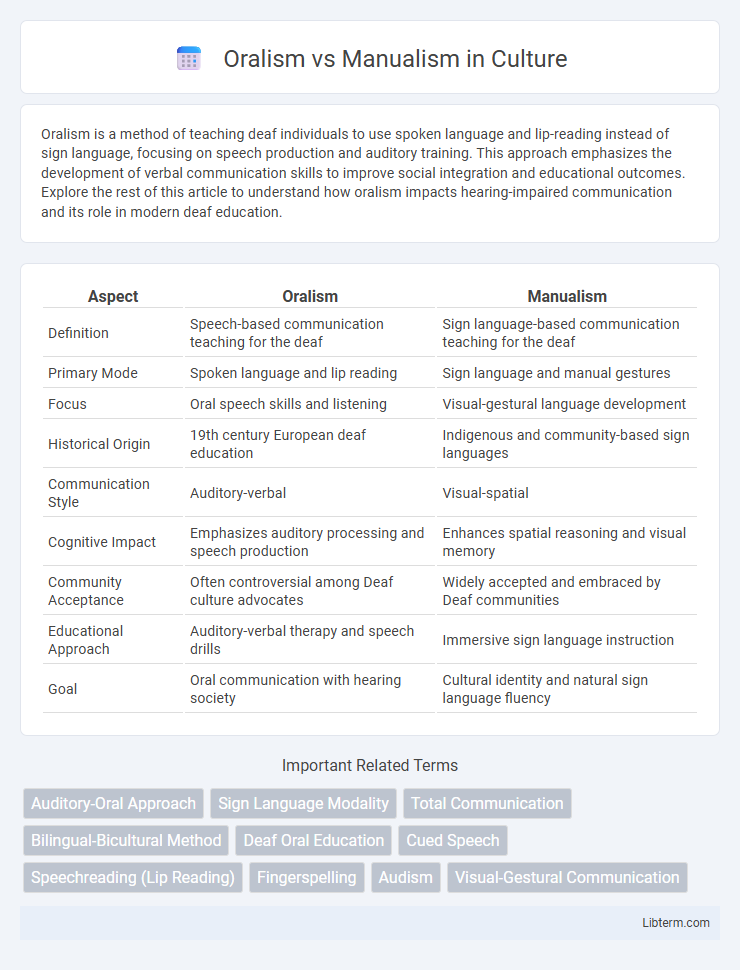Oralism is a method of teaching deaf individuals to use spoken language and lip-reading instead of sign language, focusing on speech production and auditory training. This approach emphasizes the development of verbal communication skills to improve social integration and educational outcomes. Explore the rest of this article to understand how oralism impacts hearing-impaired communication and its role in modern deaf education.
Table of Comparison
| Aspect | Oralism | Manualism |
|---|---|---|
| Definition | Speech-based communication teaching for the deaf | Sign language-based communication teaching for the deaf |
| Primary Mode | Spoken language and lip reading | Sign language and manual gestures |
| Focus | Oral speech skills and listening | Visual-gestural language development |
| Historical Origin | 19th century European deaf education | Indigenous and community-based sign languages |
| Communication Style | Auditory-verbal | Visual-spatial |
| Cognitive Impact | Emphasizes auditory processing and speech production | Enhances spatial reasoning and visual memory |
| Community Acceptance | Often controversial among Deaf culture advocates | Widely accepted and embraced by Deaf communities |
| Educational Approach | Auditory-verbal therapy and speech drills | Immersive sign language instruction |
| Goal | Oral communication with hearing society | Cultural identity and natural sign language fluency |
Understanding Oralism: Definition and Origins
Oralism is a communication method emphasizing speech and lip-reading over sign language for deaf individuals, originating in the 19th century with educators like Alexander Graham Bell advocating spoken language integration. Its goal is to facilitate spoken communication and social integration by training deaf individuals to use residual hearing, articulation, and lip movements. The oralist approach contrasts with manualism, which prioritizes sign language as the primary mode of communication within the deaf community.
Manualism Explained: History and Key Principles
Manualism, rooted in the use of sign language, emerged in the early 19th century as a cornerstone for deaf education with pioneers like Laurent Clerc and Thomas Hopkins Gallaudet advocating for its adoption. This approach emphasizes natural sign languages, such as American Sign Language (ASL), as the primary mode of communication, fostering cognitive development and cultural identity within the Deaf community. Key principles of manualism include visual-manual modality facilitation, linguistic accessibility, and the promotion of Deaf culture and identity through immersive sign language environments.
The Historical Debate: Oralism vs Manualism
The historical debate between Oralism and Manualism centers on the educational methods for deaf individuals, where Oralism emphasizes speech and lip-reading, while Manualism advocates for sign language communication. Oralism dominated Western deaf education in the late 19th and early 20th centuries, supported by institutions like the Milan Conference of 1880 that endorsed speech-only approaches. In contrast, Manualism persisted through deaf communities and schools prioritizing sign language, highlighting cultural identity and natural language acquisition for the deaf.
Educational Outcomes: Comparing Oral and Manual Methods
Educational outcomes comparing oralism and manualism reveal distinct impacts on language acquisition and cognitive development in deaf learners. Oralism emphasizes speech and lip-reading skills, often resulting in improved articulation and integration into hearing environments, while manualism prioritizes sign language, facilitating faster language development and stronger cognitive and social skills. Studies indicate that bilingual approaches incorporating both spoken and signed languages enhance overall academic achievement and communication competence.
Key Figures in Oralism and Manualism Movements
Alexander Graham Bell and Thomas Hopkins Gallaudet stand as key figures in the oralism movement, promoting speech and lip-reading techniques for deaf education. In contrast, Laurent Clerc and Edward Miner Gallaudet prominently advanced manualism, advocating for sign language as the primary mode of communication. Their contributions significantly shaped the educational approaches within deaf communities, influencing policies and cultural acceptance worldwide.
Benefits and Limitations of Oralism
Oralism emphasizes spoken language development through lip reading and speech training, benefiting deaf individuals by enhancing integration into hearing society and improving verbal communication skills. However, its limitations include potential delays in language acquisition, reduced access to natural sign language, and challenges for those with varying degrees of hearing loss. Critics argue that oralism may neglect cultural identity and social connection within the Deaf community, highlighting the need for balanced educational approaches.
Advantages and Challenges of Manualism
Manualism, emphasizing sign language for communication, offers distinct advantages including enhanced access to natural language acquisition, fostering cognitive development and social inclusion among deaf individuals. This approach ensures cultural identity preservation within the Deaf community, supporting rich interpersonal connections and mental well-being. However, challenges include limited widespread educational resources and potential barriers in mainstream integration due to variable sign language proficiency among hearing populations.
Impact on Deaf Culture and Identity
Oralism, emphasizing speech and lip-reading, often challenged Deaf cultural identity by prioritizing assimilation into hearing society, which led to the suppression of sign language and Deaf community values. Manualism, centered on sign language, reinforced Deaf culture by fostering linguistic access and communal bonds, promoting a strong sense of identity and empowerment among Deaf individuals. The tension between these approaches has deeply influenced debates over educational methods and the preservation of Deaf heritage.
Modern Approaches: Toward Bilingual-Bicultural Education
Modern approaches in Deaf education emphasize bilingual-bicultural (Bi-Bi) methods, integrating both American Sign Language (ASL) and English to support linguistic and cultural identity. Oralism focuses on speech and lip-reading skills, while manualism prioritizes sign language communication; Bi-Bi education combines these by fostering proficiency in ASL as a first language and English as a second language. Research shows that Bi-Bi models enhance cognitive development, academic success, and social integration for Deaf students by validating both Deaf culture and Deaf communication modes.
Future Trends in Deaf Education: Integrating Oralism and Manualism
Future trends in deaf education emphasize a hybrid approach integrating oralism and manualism to optimize communication and learning outcomes. Technological advancements such as cochlear implants combined with sign language interpreters create more inclusive classroom environments. This integrative model supports cognitive development, social interaction, and academic achievement by catering to diverse communication preferences within the deaf community.
Oralism Infographic

 libterm.com
libterm.com